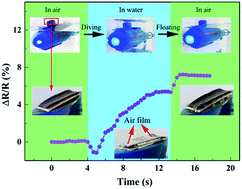Superhydrophobic heterogeneous graphene networks with controllable adhesion behavior for detecting multiple underwater motions†
Abstract
Smart materials with underwater motion detection have become a popular research topic with the development of ocean exploration. Herein, a heterogeneous polydimethylsiloxane/open-cell graphene network (PDMS/OCGN) with a micro–nanoscale hierarchical structure is fabricated via a simple inverse drying method. The PDMS/OCGN has a special microstructure due to the PDMS-coated surface and the uncoated interior, which enables the material to exhibit both strong superhydrophobicity and high electrical conductivity simultaneously. In addition, the adhesive force of PDMS/OCGNs for water droplets can easily be controlled from 70.6 μN to 34.0 μN by adjusting the coating content. On this basis, the lossless transportation of water microdroplets is achieved in this paper. By means of the typical underwater state and deformable network of PDMS/OCGNs, for the first time, a superhydrophobic material with rapid sensing capability for immersion and emersion processes, owing to the abrupt change in its resistance, is reported. More importantly, the vertical dive and horizontal movement in water can also be detected in real time. Furthermore, the PDMS/OCGN can identify the diving depth and moving speed via the degree of change in resistance. Therefore, this multifunctional PDMS/OCGN may be an excellent candidate for the fabrication of underwater sensing devices.



 Please wait while we load your content...
Please wait while we load your content...